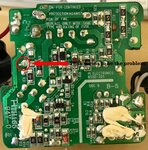brunoaduarte
Newbie level 6

Hi!
My Asus AC Adaptor (Input: 100-240V / Output: 19V) - Model AD890026 that stopped working after a drop.
- I've checked the fuse and it's ok.
- Made a visual inspection and all the solder seems fine.
- Removed and tested the yellow MPX40 part with a multimeter and it measures 283.7 nF
- The big 47 uF / 400V capacitor charges with ~190V when i connect it to the wall plug.
- No 19V output on the PCB.
Can someone help me finding the problem with it ? Where should i start looking and/or which tests could i make here ?
I've attached some pictures (including a ZIP file with the high res images).
Thanks!
My Asus AC Adaptor (Input: 100-240V / Output: 19V) - Model AD890026 that stopped working after a drop.
- I've checked the fuse and it's ok.
- Made a visual inspection and all the solder seems fine.
- Removed and tested the yellow MPX40 part with a multimeter and it measures 283.7 nF
- The big 47 uF / 400V capacitor charges with ~190V when i connect it to the wall plug.
- No 19V output on the PCB.
Can someone help me finding the problem with it ? Where should i start looking and/or which tests could i make here ?
I've attached some pictures (including a ZIP file with the high res images).
Thanks!
Attachments
-
 IMG_0157.JPG377.2 KB · Views: 241
IMG_0157.JPG377.2 KB · Views: 241 -
 IMG_0206.JPG296.4 KB · Views: 209
IMG_0206.JPG296.4 KB · Views: 209 -
 IMG_0207.JPG186.7 KB · Views: 213
IMG_0207.JPG186.7 KB · Views: 213 -
 IMG_0208.JPG179 KB · Views: 200
IMG_0208.JPG179 KB · Views: 200 -
 IMG_0209.JPG155.5 KB · Views: 206
IMG_0209.JPG155.5 KB · Views: 206 -
 IMG_0210.JPG210.9 KB · Views: 215
IMG_0210.JPG210.9 KB · Views: 215 -
 IMG_0211.JPG254 KB · Views: 211
IMG_0211.JPG254 KB · Views: 211 -
 IMG_0212.JPG238.1 KB · Views: 224
IMG_0212.JPG238.1 KB · Views: 224 -
 IMG_0213.JPG237.7 KB · Views: 241
IMG_0213.JPG237.7 KB · Views: 241 -
 IMG_0216.JPG226.3 KB · Views: 309
IMG_0216.JPG226.3 KB · Views: 309 -
asus_AD890026.zip15.5 MB · Views: 204



